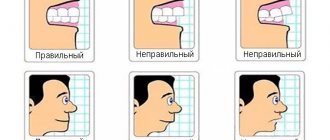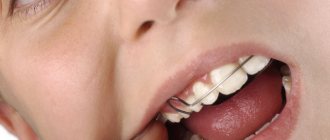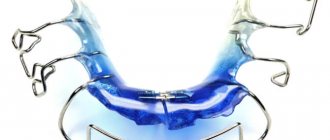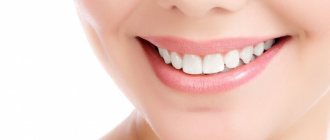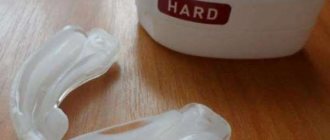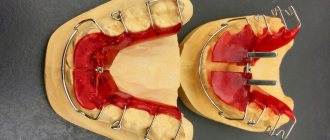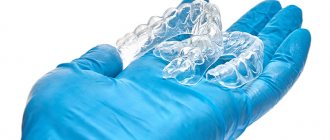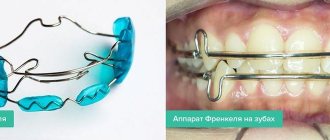This is a frequently asked question on health forums, and we're here to answer it. Beautiful and healthy teeth are not an easy task. Here you need to follow the recommendations of a specialist, a visit to the dentist and the appropriate model and company that manufactures the trainers. The process and speed of obtaining the first results depends on this.
Night guards are useful not only for children, but also for adults, since it is a universal system and has no age restrictions. The model is designed to prevent and combat dental anomalies. For adults, this is a real salvation, since you can fix even what is neglected.
Before purchasing a trainer, you need to consult with an orthopedist; he will tell you about the treatment method and select the right model.
When a doctor recommends correction with trainers
Trainers are used to straighten teeth when a patient is diagnosed with a malocclusion. Pathology can have different manifestations, so the possibility of wearing a corrector to obtain an effective result is assessed by the orthodontist individually for each patient.
In certain cases, trainers can replace a brace system if they have contraindications to wearing it. However, the corrective abilities of trainers are inferior to braces, although only slightly.
Other indications for wearing orthodontic trainers:
- deviation in tooth growth (location, direction, etc.);
- swallowing dysfunction;
- pathologies of the oral cavity leading to chronic nasal congestion.
The peculiarity of the device lies in its effect on the cause of the disease. Wearing trainers helps develop the jaw muscles, reduce pressure on the jaw bones, restore breathing through the nose and correct tongue position.
How to put on and wear a trainer correctly. How long does it take to get used to
Adult and children's dental trainers are put on and worn the same way. Installing the device is quite simple:
- Place the device in your mouth so that the central stop is directed towards the upper palate. Next, find a position so that the stopper rests on the tip of the tongue and does not create discomfort.
- Move your lower jaw in different directions until the plates fit on the molars. Have you stopped slipping? You have achieved the desired result.
- Close your jaws with little force. You should feel pressure on all your teeth. You can touch the tip of the trainer with your tongue to feel if it fits correctly.
- Check if the trainer is positioned correctly: tighten your lips and take 3-4 deep breaths. If breathing is difficult, repeat the previous steps until it becomes easier.
You need to wear the trainer for 1-4 hours during the day, as well as throughout the night. The regimen is determined by the doctor and must be followed. You can hold it for 30-40 minutes, but you cannot use the device less than necessary. If you need to remove the trainer, try to return it to its place as quickly as possible.
While wearing it, a person should not talk, eat or drink. If you are going to wear a trainer with your child, it is better to come up with entertainment for him during classes, for example, you can watch a cartoon or a movie, or draw. The habit of wearing a trainer develops over different periods of time – it all depends on the patient. At night, it is better to monitor the device regularly for at least a month (it may crash). During the day, the discomfort disappears in about a week, sometimes less.
Do not forget that while wearing a trainer, it is important to see a doctor once every two to three months. A visit to the orthodontist is a necessary procedure, because it allows you to determine the dynamics of changes in the dentition and correct the process in time if something goes wrong.
For whom are they contraindicated?
Correction with an orthodontic device to correct the bite may not always be carried out. Experts advise postponing the start of treatment in case of exacerbation of chronic diseases, especially those associated with impaired nasal breathing.
There are no significant contraindications. In addition to the listed limitations, treatment is not recommended for lateral crossbite. In case of hyperactivity and uncontrolled behavior of a child, correction takes place under the strict supervision of parents and a doctor.
If there are contraindications, you can choose another method of correcting the bite. Based on the clinical picture and characteristics of the child’s psycho-emotional behavior, the clinic’s specialists will select the most effective system that will not pose any risks to the child’s health.
Trainer care rules
The operational life of the device and the health of the patient’s oral cavity depend on proper cleaning of the trainer after each use.
Fortunately, trainers are convenient and practical to care for, unlike fixed dental structures. They are simply removed and washed with running water without the use of additional products. But the characteristics of the material require following certain rules when cleaning the trainer:
- Do not rinse the trainer with water of too high or too low a temperature, this may cause deformation of the silicone or polyurethane, and the product will lose its shape and, consequently, its functionality.
- There is no need to rub the trainer vigorously with hard objects, scratch it or stretch it. Otherwise, the trainer will not work effectively and properly influence the dental units.
- Sometimes there is a need to clean the trainer using soap or toothpaste, since running water does not always effectively remove all contaminants; bacteria that cause caries multiply on them.
- Trainers should be stored in a special plastic container so that it does not become damaged or dirty while not in use.
If cracks or other deformations appear on the product, it is necessary to immediately notify the attending orthodontist, since the structure may lose its functional properties, and pathogenic microorganisms may accumulate in the damage.
Timely installation of trainers will prevent further deformation changes in the human jaw.
Advantages
An orthodontic trainer is a product similar in appearance to mouth guards. The device is made of polyurethane or silicone.
Advantages of correction using mouth guards-trainers:
- in terms of their effectiveness they are not inferior to braces (with the exception of complex bite pathologies);
- do not require round-the-clock wearing;
- installed for only a few hours a day;
- allow you to avoid aesthetic defects that arise during treatment with braces;
- ease of care (regular toothpaste and toothbrush are suitable);
- there is no effect on tooth enamel and soft tissues;
- mechanical injuries are excluded;
- elimination of the cause of the pathology, the disease itself and its consequences;
- do not require individual manufacturing, since the device has a universal size.
The popularity of the corrector is also explained by its cost. The price for trainers for straightening teeth is three times lower than for braces. The disadvantages include the need to strictly adhere to treatment tactics.
conclusions
Trainers for teeth straightening are a modern and relatively painless way to combat dental anomalies and bite problems. The orthodontist prescribes wearing the device if there are certain indications, for example, swallowing is impaired, teeth are displaced, and it is not possible to install braces. Contraindications for installing trainers include chronic nasal breathing problems and crossbite.
Trainers have many advantages: most often the choice in their favor is made due to the low price and safety of the system, since it does not affect the enamel and does not irritate the mucous membranes. But there are also disadvantages, the most negative is the slow effect on the dentition. But the effect will still be there. True, you need to choose the right product among all varieties.
The trainer is easy to get used to and easy to care for. But at the same time, wearing it gives much more than conventional braces: the device eliminates the cause of malocclusion and reduces the risk of similar problems occurring in the future. This is why many orthodontists prescribe wearing trainer systems, both separately and together with the installation of braces.
Types of dental trainer models
Bite pathology can be of different types. The design has an element at the base, which exerts varying degrees of pressure on the teeth. They produce soft, medium and hard correctors. Depending on the complexity of the defect, a trainer is selected according to the degree of rigidity. Orthodontic products are distinguished by their intended use.
Pre-orthodontic
Preorthodontic trainers are a device that is designed to correct dental growth pathologies in children with primary teeth. This model has no analogues.
Two types of construction are produced, taking into account all the features of the period of change of baby teeth:
- Infant - for 4–6 years;
- T4K - for 6–10 years.
Pre-orthodontic trainers can also be used to prevent malocclusion, under the influence of provoking factors:
- constant breathing through the mouth;
- hypertonicity of the temporomandibular joint;
- bad habits (finger sucking, nail biting, etc.);
- improper teething.
Wearing a trainer is also recommended in case of premature loss or removal of baby teeth. It is necessary to wear such a design until the teeth erupt, regardless of the age at which they were lost.
Finishing
Orthodontic trainers of the “finish” type can be recommended by a specialist to be worn by a child aged 10 to 13 years. They are prescribed mainly for preventive purposes after wearing other correctors, to strengthen the enamel if the child is prone to bad habits, to reduce muscle tone and form a swallowing reflex.
Orthodontists also prescribe this device after wearing braces to consolidate the result or to correct defects that have arisen after the removal of the braces. In this case, you will need the finishing model or, as it is also called, “retainers.”
If the bite is corrected with braces, then long-term wearing of retainers is considered a necessary measure used to prevent the reverse displacement of teeth.
For braces
A special type of therapeutic trainers for braces. Both orthodontic devices are used simultaneously, but only in certain cases:
- increased muscle pressure;
- protection of oral tissues from damage at night;
- bad habits.
With complex correction, it is possible to achieve the results of functional and hardware treatment, increasing the effectiveness of both structures.
Cost of dental trainers
The price of dental trainers is much lower than installing braces or surgical treatment. The amount varies from 2000 to 6000 rubles. Before using the device regularly, you will definitely need to consult a specialist, which can be done in a private office or clinic.
Dental trainers should only be used regularly if prescribed by a doctor. The specialist will determine a list of physiological disorders and also assess the prospects for treatment.
This article is for informational purposes only, please consult your doctor for details! Ask your doctor about contraindications and side effects.
Advantages of trainers over other correctors
When analyzing the action and effectiveness of all orthodontic devices for correcting malocclusion, according to the opinions of orthodontists, trainers have three main advantages:
- do not require constant use - the factor of non-aesthetic teeth, which often causes discomfort in society, especially among children, is eliminated;
- lack of pressure on the teeth - the effect is on the entire jaw by limiting the freedom of space, but without the absence of directional pressure;
- ease of installation - the patient can remove and install the trainers independently without additional assistance from a specialist.
Reviews of dental trainers confirm the effectiveness of the design, but only if all operating rules are observed, including indications and treatment regimen. In patients who violate correction tactics (irregularly wearing the device), the treatment result may not correspond to the expected one.
Why trainers are better than other orthodontic devices
Unlike braces, they do not need to be worn constantly. They are worn at night and for a couple of hours during the day. This is very convenient for adults who care about the aesthetics of their smile, and for children who may suffer from ridicule from classmates. After all, various taunts are very often directed at guys with plates or braces.
Another advantage is minimal discomfort, absence of pain and soft tissue injuries. Braces and plates put pressure directly on the teeth, and wearing them is often painful. In addition, they often injure or irritate the oral mucosa.
Features of treatment with trainers
A malocclusion can be noticed independently or diagnosed by a dentist during a routine examination. The need to wear trainers is determined by the orthodontist based on the results of consultation and diagnosis.
The corrector must be worn from 1 to 4 hours a day. The treatment regimen is determined by the doctor. It is not recommended to reduce the operating time of the device. You should choose the most convenient period during the day.
Orthodontists recommend wearing a trainer in the evening, since while the device is in the mouth, you cannot talk, drink or eat. Habituation occurs within a week. If a corrector is prescribed to be worn at night, then the child is monitored during the first month, since the trainer may fly out or the child involuntarily removes it.
The average duration of treatment is one year. During this period, you should visit the orthodontist every 2-3 months to monitor the changes that are occurring.
Trainers for straightening teeth are considered the most effective corrector for malocclusion pathologies. You can install an orthodontic device at the Martinka Clinic. Our specialists provide an individual approach to choosing a product model and determining a bite treatment plan. You can make an appointment with an orthodontist, find out how much teeth straightening trainers cost, or other information by calling or visiting the pediatric dentistry website.
Care instructions
The rules of care are very simple:
- After removing the trainer from your mouth, you must rinse it with running water;
- periodically it needs to be cleaned with a toothbrush and toothpaste;
- the device should be stored in a special container;
- While the trainer is in the mouth, patients are prohibited from talking or opening their mouth;
- the structure cannot be chewed, gnawed, boiled, or washed with very hot or very cold water;
- Once every one or two months you need to see an orthodontist to evaluate the results;
- In case of mechanical damage, the device should be immediately taken to the orthodontist.
Category Orthodontics Published by Mister stomatolog
Indications and contraindications
Main indications for use of the trainer:
- deformation of the dentition due to bad habits;
- deep bite, cramped teeth;
- malocclusion in the anterior region;
- collection of teeth in the frontal region of the lower jaw;
- difficulty swallowing, speech defects, etc.
List of contraindications to the use of trainers:
- pronounced crossbite, when the frontal incisors of the mandibular row are located in front of the upper teeth;
- crossbite in the lateral areas;
- mental problems;
- difficulty breathing with a severe runny nose.
For what reasons can a malocclusion develop?
Before moving on to questions about how to properly wear trainers to straighten teeth and how much they cost, you should consider the main reasons leading to the formation of dental anomalies. So, among the provoking factors, experts in the field of orthodontics identify the following prerequisites:
- bad childhood habits, such as holding a finger in your mouth while sleeping or sucking on a pacifier,
- incorrect position of the frenulum, the need to trim it,
- mouth breathing as a consequence of diseases of the ENT organs,
- artificial feeding - pediatricians note that when a baby is fed through a bottle, his jaw muscles tense less, which slows down the process of their proper development,
- hereditary predisposition,
- disturbances in the process of intrauterine development of the fetus, its infection, disruptions in metabolism - all this can most directly affect the correct formation of the dental system1,
- chronic, viral and infectious diseases in the mother during pregnancy.
Bad childhood habits can lead to malocclusion.
Other reasons can also provoke problems, for example, birth trauma or doctor errors during the removal of baby teeth. Other possible prerequisites include disruptions in the process of teething, poor nutrition, and a lack of vital vitamins and microelements in the body.
